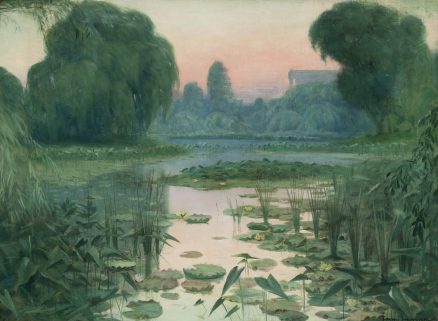Untitled (Jackson Park, Chicago)
, circa 1894–1896Oil on canvas, 21½ by 29½ inches
- Zoom in on Artwork
- Print Page
- Email Page to Friend
Best known among his contemporaries for dramatically tinted sunset snow scenes, Svend Svendsen also painted marines and “bits of American shore, ocean, and lake.”i In this intimate work he focused on willows, reeds, and waterlilies encroaching on still water as it reflects the clear sky of sunset tinged with delicate pastels. Into this seemingly natural, deserted scene, the looming silhouette of a distant massive building intrudes in the right distance. The suggestion of a columned portico evokes a classical temple, a stock European landscape motif associated with memory, time’s passage, and the futility of worldly ambition.
In the 1890s Svendsen, in company with other Chicago artists, began depicting the city; his Afternoon—Chicago River, for example, was reproduced in the Chicago Tribune of February 23, 1896. Untitled (Jackson Park, Chicago), in contrast, gives no hint of the bustling commercial metropolis the artist called home. Svendsen’s own title for this romantic painting is unknown, but its subject has been credibly interpreted as the site of the World’s Columbian Exposition, the gargantuan international fair staged in Jackson Park on Chicago’s southern lakeshore in 1893.
A year after the fair closed, most of its structures were in ruins. One of the few that survived was the massive Palace of Fine Arts, which faced south at the northern end of an irregular lagoon that dominated the fair’s layout. Thanks to its sturdy fireproof construction, designed to protect the priceless art collections it housed for the fair’s duration, the Palace of Fine Arts lived on as the home of the Columbian Museum of Natural History. (Decades later, after the renamed Field Museum of Natural History moved into its new home closer to Chicago’s Loop, the former Palace of Fine Arts reemerged as the home of the newly founded Museum of Science and Industry.) In the aftermath of the exposition, as the abandoned fairgrounds and lagoon yielded to nature and the nation sank into an economic depression, the pale stone building with its restrained Beaux-Arts classicism stood as a ghostly memorial to the departed glories of the exposition. The original structure lacked the open portico indicated by the light surrounding the supporting column in Svendsen’s image, a liberty the artist may have taken to emphasize the classical character of the edifice seen from afar in the fading light. Svendsen’s elegiac interpretation of this Chicago site shares with his more typical rural landscapes an emphasis on the power of end-of-day color and light to transform the landscape into an idyllic realm of fantasy.
Wendy Greenhouse, PhD
Donated by M. Christine Schwartz to The Richard H. Driehaus Museum, Chicago, Illinois, in 2023
i “Art,” Chicago Inter Ocean, Oct. 31, 1897.
